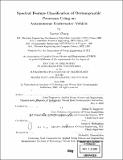Spectral feature classification of oceanographic processes using an autonomous underwater vehicle
Author(s)
Zhang, Yanwu
DownloadFull printable version (15.94Mb)
Other Contributors
Joint Program in Applied Ocean Science and Engineering.
Advisor
Arthur B. Baggeroer and James G. Bellingham.
Terms of use
Metadata
Show full item recordAbstract
The thesis develops and demonstrates methods of classifying ocean processes using an underwater moving platform such as an Autonomous Underwater Vehicle (AUV). The "mingled spectrum principle" is established which concisely relates observations from a moving platform to the frequency-wavenumber spectrum of the ocean process. It clearly reveals the role of the AUV speed in mingling temporal and spatial information. For classifying different processes, an AUV is not only able to jointly utilize the time-space information, but also at a tunable proportion by adjusting its cruise speed. In this respect, AUVs are advantageous compared with traditional oceanographic platforms. Based on the mingled spectrum principle, a parametric tool for designing an AUVbased spectral classifier is developed. An AUV's controllable speed tunes the separability between the mingled spectra of different processes. This property is the key to optimizing the classifier's performance. As a case study, AUV-based classification is applied to distinguish ocean convection from internal waves. The mingled spectrum templates are derived from the MIT Ocean Convection Model and the Garrett-Munk internal wave spectrum model. To allow for mismatch between modeled templates and real measurements, the AUVbased classifier is designed to be robust to parameter uncertainties. By simulation tests on the classifier, it is demonstrated that at a higher AUV speed, convection's distinct spatial feature is highlighted to the advantage of classification. Experimental data are used to test the AUV-based classifier. An AUV-borne flow measurement system is designed and built, using an Acoustic Doppler Velocimeter (ADV). The system is calibrated in a high-precision tow tank. In February 1998, the AUV acquired field data of flow velocity in the Labrador Sea Convection Experiment. The Earth-referenced vertical flow velocity is extracted from the raw measurements. The classification test result detects convection's occurrence, a finding supported by more traditional oceanographic analyses and observations. The thesis work provides an important foundation for future work in autonomous detection and sampling of oceanographic processes.
Description
Thesis (Ph.D.)--Joint Program in Applied Ocean Science and Engineering (Massachusetts Institute of Technology, Dept. of Ocean Engineering/Woods Hole Oceanographic Institution), 2000. Includes bibliographical references (leaves 202-211).
Date issued
2000Department
Joint Program in Applied Ocean Physics and Engineering; Woods Hole Oceanographic Institution; Massachusetts Institute of Technology. Department of Ocean EngineeringPublisher
Massachusetts Institute of Technology
Keywords
Ocean Engineering., /Woods Hole Oceanographic Institution. Joint Program in Applied Ocean Science and Engineering.